The typical egg dish in Japanese cuisine, dashimaki tamago (出し巻き卵, Japanese rolled omelette) is made by rolling thin layers of egg in the frypan. The beautiful layers of the egg when sliced, and the sweet dashi flavour make this omelette so unique.
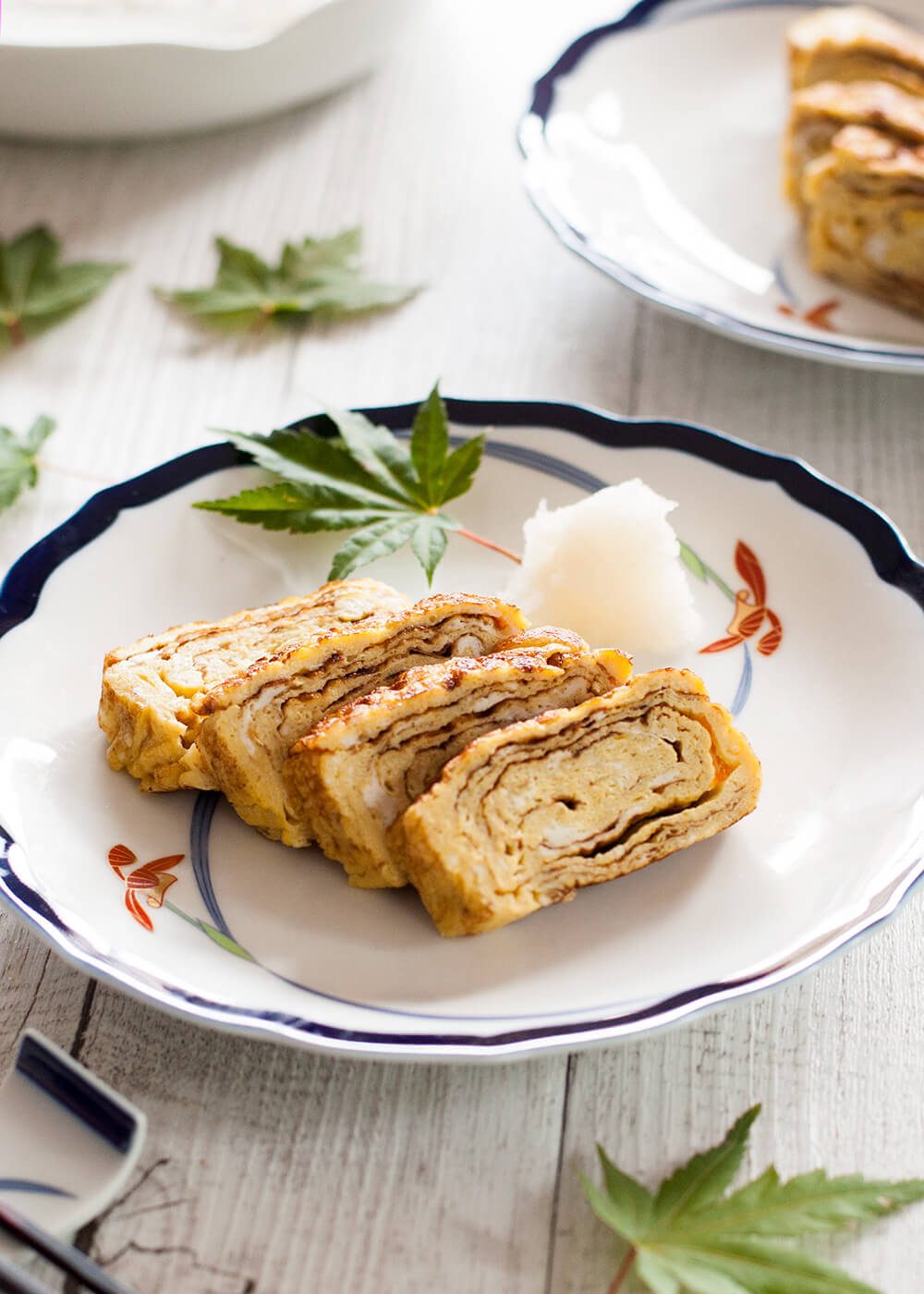
Japanese cuisine and dashimaki tamago are like omelettes for breakfast in Western culture. But dashimaki tamago is served not just for breakfast but for many different occasions and in different dishes.
If you have a Japanese style breakfast, often you will find a slice of dashimaki tamago among the several dishes on the table. You will also find dashimaki tamago in lunch boxes, particularly in the popular lunch box called makunouchi bento (幕の内弁当) which consists of rice, pickles, meat, fish, vegetables and egg.
At Izakaya (Japanese style taverns), a large portion of dashimaki tamago is served with grated daikon (white radish). Why grated daikon? I am not sure the real reason for it but all I know is that daikon goes well with dashimaki tamago.
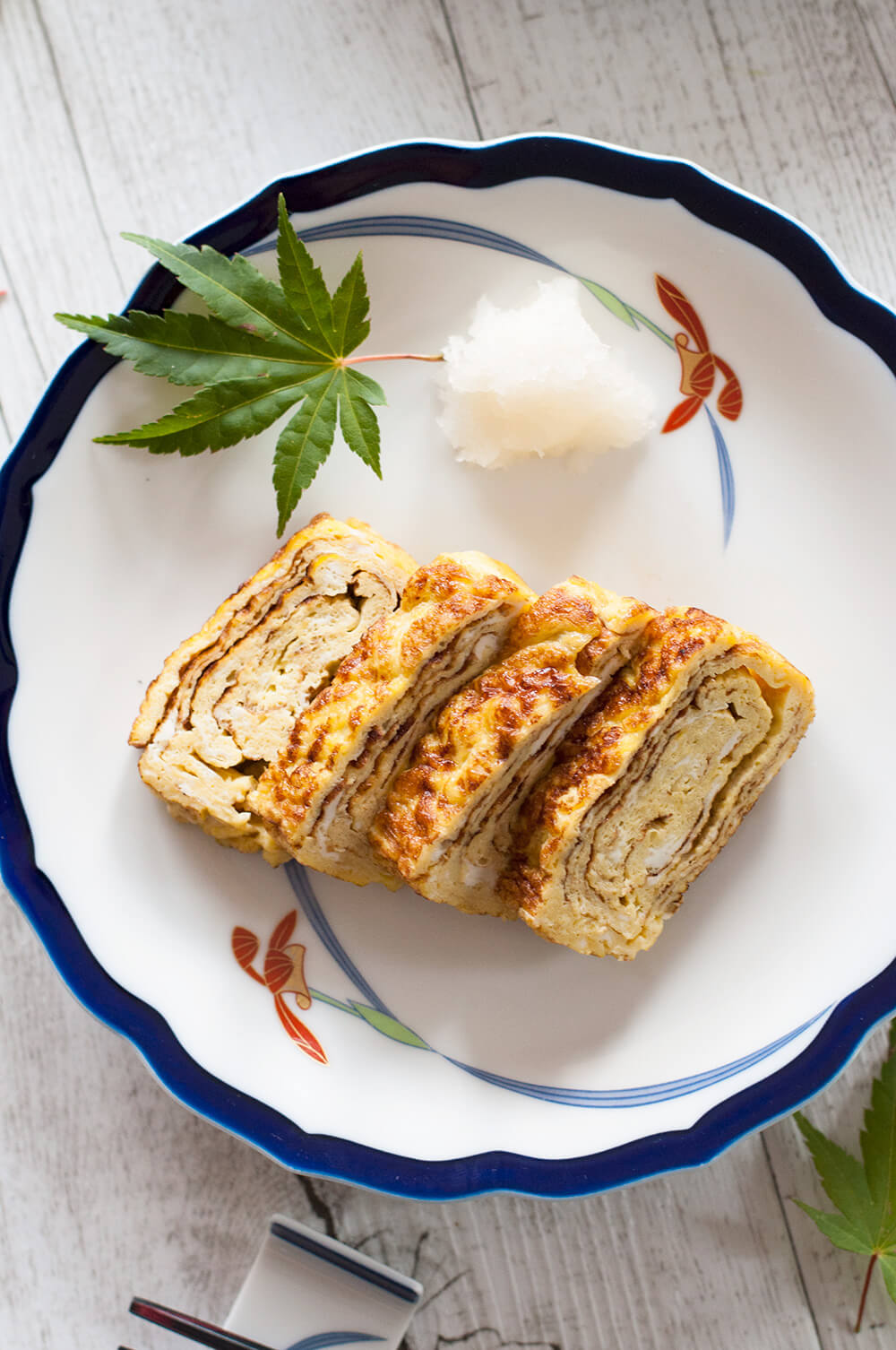
Dashimaki tamago is also a regular sushi item, particularly nigirizushi (small rice ball with raw fish on top). When you order a set of nigirizushi, you always get a piece of nigirizushi with a slice of dashimaki tamago on it. This is the only traditional nigirizushi item that is not fish.
Unlike Western style omelettes, dashimaki tamago has a sweet flavour with dashi, sake, sugar and soy sauce. Some recipes even add mirin to it. I am not fond of very sweet dishes so my recipe does not use mirin. It uses a small amount of sugar to give only a subtle sweetness. You do taste dashi and that’s where the name “dashimaki tamago” came from. The word “maki” means “rolled” and “tamago” is “egg”.
Dashimaki tamago is made by rolling the thinly spread egg. The rolled egg is pushed to one side, more egg is added into the pan and the previously cooked egg is rolled over the thin egg to make layers of egg. It is meant to be a long rectangular shape and the Japanese use a rectangular tamagoyaki pan (omelette frypan) which is made just for this. It makes the shaping of dashimaki tamago easier. You can see in the step-by-step photos at the end of the recipe how it is used.
Most households outside of Japan are unlikely to have such a frypan. But no worries. You can make rectangular dashimaki tamago using a round frypan too. See the photos below. I am afraid it is not a perfect dashimaki tamago. Since I always use the rectangular tamagoyaki pan, I am not used to making it with a round frypan!
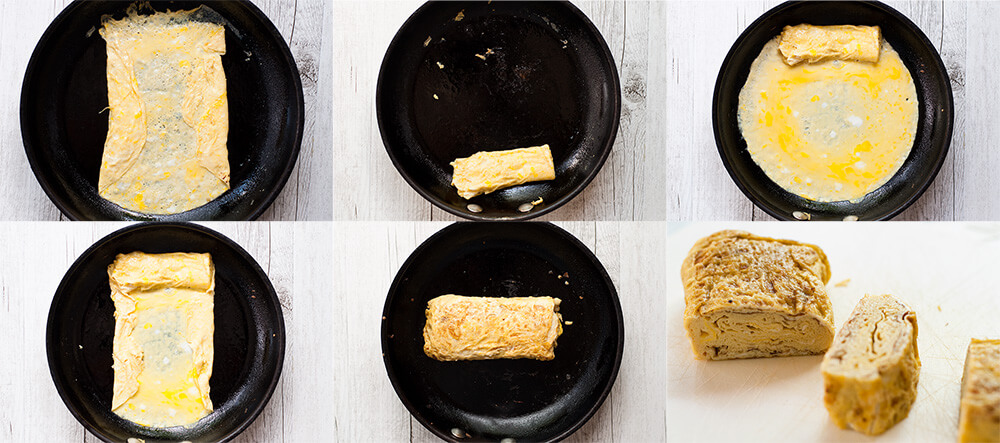
Just like making an omelette, making dashimaki tamago looks simple but it is technically challenging. It is quite difficult to make a perfect one like those served at expensive Japanese restaurants or sushi restaurants. I cannot make them like that. But I believe anybody can make dashimaki tamago which looks like it and tastes great. You just need to know a few key things.
- Amount of dashi – dashi gives better flavour to dashimaki tamago and makes the egg juicier but too much dashi makes it more difficult to roll as the ratio of the egg, which helps glue everything together, in the egg mixture becomes less.
- Beating the egg – to make a fluffy rolled egg, you don’t beat the egg vigorously but make sure that the egg whites are broken down into smaller bits. Move the chopstics or the fork sideways in the egg to beat the egg instead of using a whipping action. Lift up a chunk of egg whites with chopsticks or a fork and let it dribble through the chopsticks/fork to break into small chunks.
- Oil the frypan each time before pouring in the egg.
- Temperature of the frypan – the egg should not be cooked too fast or too slow, so the frypan should be on medium low to medium heat.
- Timing of rolling the egg – the surface of the egg should neither be completely cooked, nor completely wet and uncooked.
Professionals make dashimaki tamago using chopsticks which is a pretty hard thing to do. You would say, “how can you fold a soft and thin wide sheet of egg with just two sticks?”. I can tell you, it’s really hard. I used to be able to do it when I was cooking Japanese meals everyday but not anymore. I was actually shocked to learn that a different lifestyle takes away certain culinary skills!
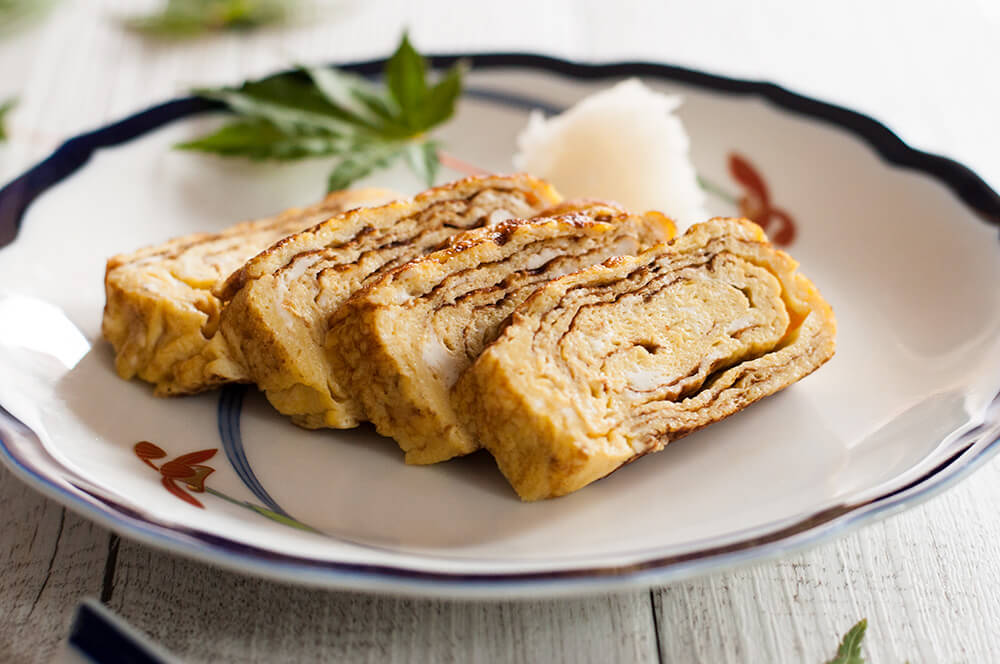
When you slice dashimaki tamago, you will notice the layers of egg. I love the pattern of the thin layers of the egg. So I purposely burn each layer slightly to make the lines stand out. But the down side of making burnt lines is that the each layer tend to get separated unless the timing of rolling the egg is perfect. You can see the separation of the layer in my photo. They are meant to be glued together but I was too slow to roll! My son was very quick to point it out when he taste tested.
If you Google search “dashimaki tamago”, you will notice that most of them don’t have brown lines in the layers like mine. Perhaps dashimaki tamago with brown lines is not the common version but I like it that way. If you prefer, you could make dashimaki tamago without distinct lines. Just use a slightly lower heat and start rolling the egg before it gets browned.
We had a family temakizushi (手巻き寿司, hand rolled sushi) day few weeks ago and dashimaki tamago was one of the ingredients to go into the temakizushi. Here is a snap peek at “Temakizushi” which I will be posting soon. So watch this space!
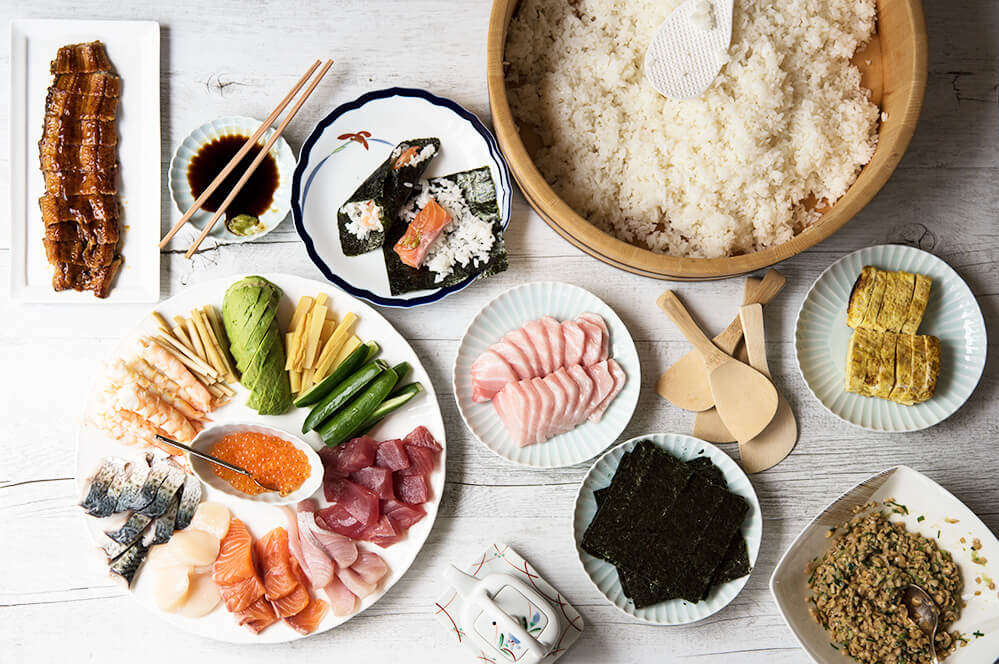
Yumiko![]()
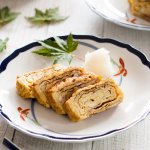
- 4 eggs (note 1)
- 4 tbsp dashi stock (note 2)
- ½ tbsp light soy sauce
- ½ tbsp sake
- 2 tsp sugar
- 1½ tbsp oil with a small piece of paper towel soaked in
- 2 tbsp grated daikon (white radish)
-
Gently beat eggs in a bowl or a large measuring cup, trying to cut the egg white into small chunks but do not beat hard (note 3).
-
Add all the ingredients except oil into the bowl/measuring cup and mix until sugar is dissolved.
-
Place a non-stick frypan (note 4) or a tamagoyaki pan over medium low to medium heat and oil using the oil-soaked paper towel as if you are wiping the pan so that the amount of oil is not excessive.
-
When the frypan and oil is heated up (note 5), pour about 1/5 of the egg mixture into the pan. The egg should start cooking straight away and you should see some bubbles lifting the surface of the egg.
-
Poke the large bubbles to flatten using chopsticks or the edge of a spatula.
-
When the surface of the egg starts drying but is still half wet, fold the both sides of the egg sheet inwards using a spatula so that the sides are straight instead of round (frypan only). Use a spatula to roll the egg starting from the furthest end from you. Place the spatula underneath the egg about 1.5cm (½”) into the egg, then lift and flip towards you. It will fold with about 1.5cm (½”) width.
-
Repeat to roll the rest using the first fold as the core of the roll until the egg roll shifts to the end of the frypan closest to you.
-
Tidy up the rolled egg using the spatula so that the width of the egg is even (note 6).
-
Lightly oil the farthest end part of the frypan using the oiled paper towel. Slide the egg to the farthest end of the frypan and oil the rest of the frypan lightly.
-
Pour 1/5 of the original egg mixture amount to the frypan. Do not pour the egg mixture over the cooked egg roll but lift the egg roll slightly so that the new egg mixture goes underneath it.
-
Repeat steps 5 to 10 until the egg mixture is used up (note 7), ending with step 8.
-
Transfer the egg to a cutting board (note 8). Slice it or dice it and place the pieces on serving plates.
-
Squeeze excess water out of grated daikon, add it next to the egg slices and serve.
1. I used small eggs and total weight not including shells was just over 200g (7oz).
If your eggs are very large, the total weigh could go close to 50% more than what I had. Then please adjust the other ingredients, accordingly.
Slight variations to the total weight of eggs should not require adjustment.
2. Please refer to my post, Home Style Japanese Dashi Stock.
3. Move chopsticks or a fork sideways in the egg to beat the egg instead of using a whipping action. Ensure that egg whites are broken down into smaller bits.
4. I used 23cm (9") frypan which has the bottom size of 19cm (7½") in diameter. Any larger than this will make a flatter dashimaki tamago as the egg will spread wide and thin.
If the frypan is smaller you will need to add smaller quantity of egg at a time so that each layer of egg is not too thick. Small pan will make a thicker dashimaki tamago.
5. Drop a tiny amount of the egg in and if the egg cooks gently, making a sizzling noise, the frypan is ready (about 180C/356F). If the egg cooks instantaneously, the temperature of the frypan is too high.
6. It is important to shape the first roll with even width otherwise you will end up with deformed rectangular dashimaki tamago. You could also gently press down the egg roll using the spatula if the surface is uneven.
7. Until you are used to making dashimaki tamago, I would recommend using a measuring cup for the egg mixture so that you can cook the same amount of egg mixture each time. It is important to cover the entire frypan with the egg when poured.
8. If the shape of the dashimaki tamago is uneven, you could correct the shape while it is still hot. Place a baking paper over the egg and use both hands to hold and press to shape it (see the step-by-step photo below).
If you have a bamboo mat which is used to make sushi rolls, then you could place the dashimaki tamago on it and warp it to shape. This will make a dashimaki tamago with round corners.
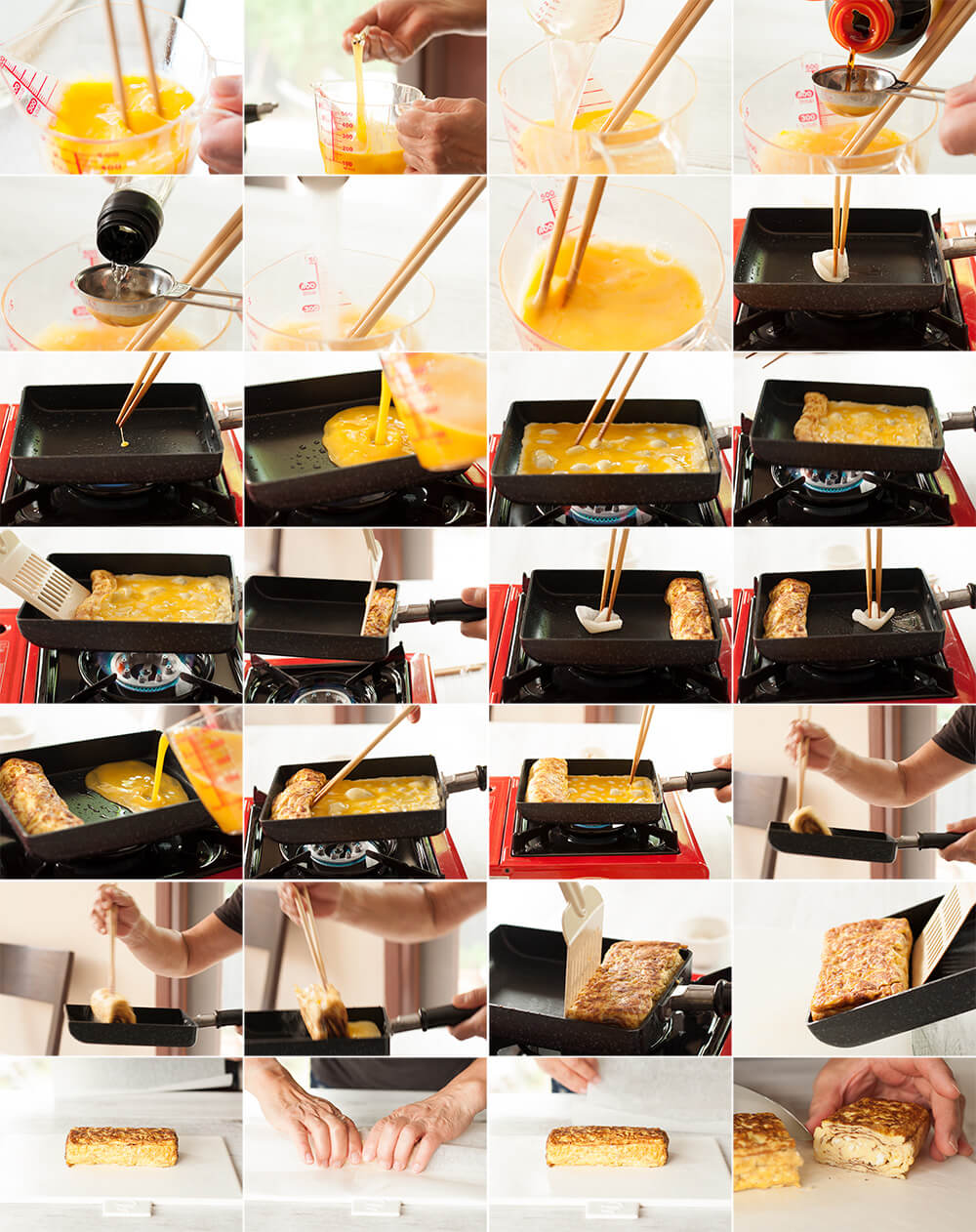
Yumiko-san,
Wonderful recipe and worked perfectly with your detailed pics for perfect construcation.
I used a bamboo mat to roll at completion, but having difficulty cleaning out the egg bits in between all the bamboo pieces. Any hints on how to clean the bamboo?
Hi Hiroyuki-san. I am glad your Dashimaki Tamago was successful. It is indeed a tedious job to clean the bamboo mat. I do the following: 1. Leave the mat in warm water for 30 min or so to make the food bits soft. 2. Use a dishwashing brush to scrape off the bits (moe the brush along the bamboo sticks as well as across them on both sides). 3. Wash off under running water (you may need to use the brush to take stubborn bits off). 4. If the mat is greasy, use a sponge soaked with very thin dishwashing liquid and wash quickly and rinse. 6. Make sure that the mat is completely dried. (I leave it on the bench for a couple of days).
Yumiko-san,
Domo arigato. This technique worked quite well with a bit of scrubbing with a brush. If I used clear cling wrap around the omelet before then wrapping with the bamboo mat, do you think that would help shield the bamboo from all the egg bits and still allow for a good presentation??
I love your recipes!! I try to do them all, if I have the major ingredients here in Maine, USA….very difficult sometimes. Most recently the curry fried rice and the dry curry (have to reduce the amount of curry powder a bit from your recipe!). We don’t have winter melon here unfortunately.
Hi Hiroyuki-san, wrapping your bamboo mat with cling wrap is a good idea. You can also place the mat inside a large plastic bag.
It’s unfortunate that winter melon is not available in Maine. I have not tried this. but I wonder if you can use the white part of watermelon skin as an alternative…. I know for certain that people in JApan do make simmered dish with it.
Totally get that this may be a blasphemy question but…is there anyway to make this in the oven? i’m thinking of the thick, sweet egg tamago you get at restaurants…
Hi Mira, I have never tried this but I read in the Japanese web site that you could make Dashimaki Tamago-like dish in the oven. Using the same ingredients, pour the mixture in a loaf tin and bake at 180°C / 356°F. When the outer part of the mixture starts getting cooked, fold the outside into the centre and mix the cooked egg and uncooked egg. Repeat until the egg is cooked through. It’s worth trying!
Hi,
You mention in your comments that you use sugar but no mirin. If I wanted to use mirin instead of the sugar, how much would I use?
Hi Lynne, the amount of sugar in mirin is about 1/3 of the same quantity of sugar. So you will need three time as much of mirin as the sugar in the recipe. If you are replacing sugar with mirin, I’d suggest omitting sake because (1) mirin contains alcohol, (2) the mixture will have too much liquid otherwise.
Domo arigato gozaimasu! (did I get that right?) And thanks especially for explaining it so concisely.
Hi Lynne, Dōitashimashite. Yes, you got it perfect!
Delicious. Perfect.
Great!
Hello yumiko, this is a Japanese recipe that I really wanted to try, since I do not have a tamagoyaki pan, I will try with a non-stick pan.
https://www.amazon.com/Asahi-Cne117-Tamagoyaki-Professinal-Wooden/dp/B0009PNBMK/ref=cm_cr_arp_d_product_sims?ie=UTF8
On this page, in the photos there is an image that seems to show differences between tamagoyaki pans so I wonder, if I bought a copper pan, would this improve the omelette somewhat?
I hope to update about the result of this recipe.
Also, I appreciate the gum-ae recipe, I just use spinach instead of chrysanthemum leaves and now it’s my favorite, I do it once a week
Hi Ruth, the copper tamagoyaki pan is the best. It browns the outside more evenly than other pans, cooks faster mad the cooked egg fluffier. The link you gave me even comes with a wooden lid which can be used to form a rolled omelette into rectangular easily. But the copper pan is very expensive. I don’t have one but the photo made me want one!
I am glad that you liked goma-ae. Spinach was a great alternative.
Hello,I check your blog named “Pinterest” like every week.Your writing style is awesome, keep up the good work! And you can look our website about proxy free list.
Thanks for the recipe! My first attempt was successful!
Yay! Thanks for letting me know, Jessica.
Konnichiwa Yumiko-san! What a fascinating post! You omelette is so much more pleasing to the eye than a Western omelette and I like your browned edges! I think it would take a good bit of practice to make one that looks like yours, but what fun it will be! Your Temakizuski feast looks wonderful, I look forward to that post!
Hi Dorothy-san. My dashimaki tamago is nowhere near the perfect one. But rolling the thin layer of egg is not as difficult as it looks. As long as you use a spatula! I did not show in the photo but it will make a great finger food if you dice it into a bite size.